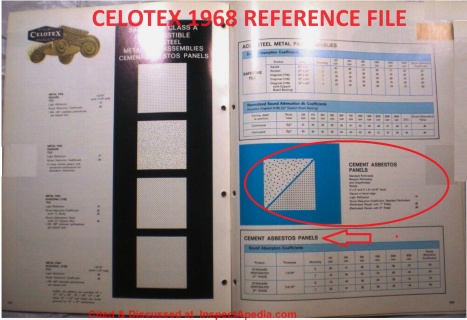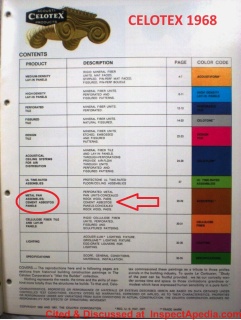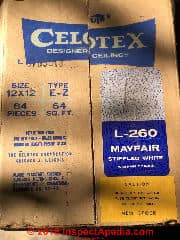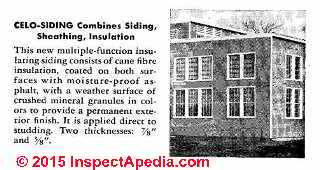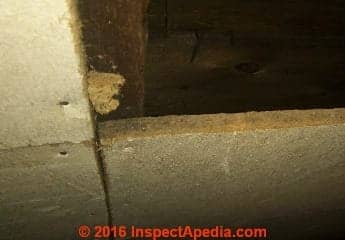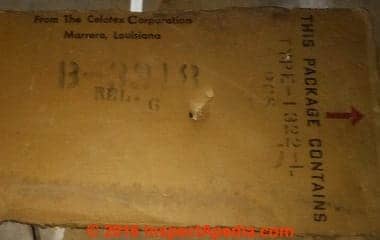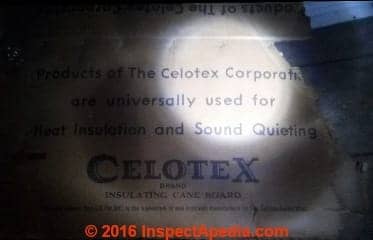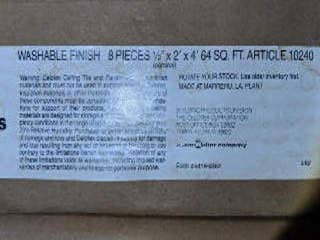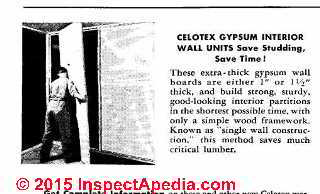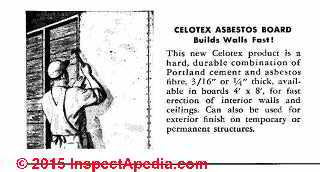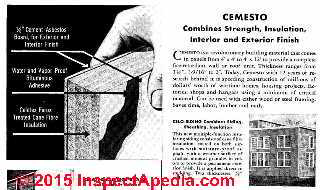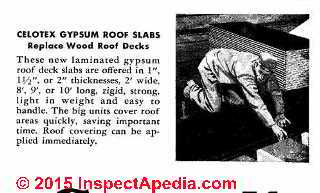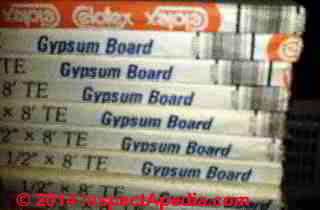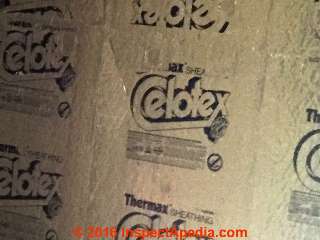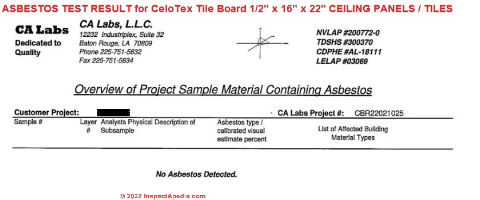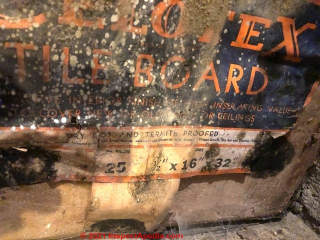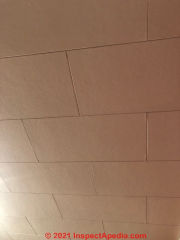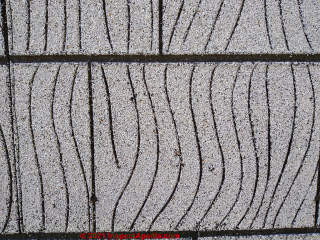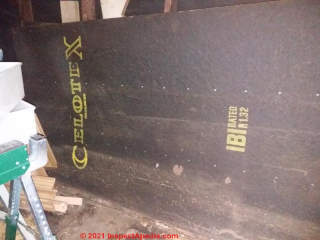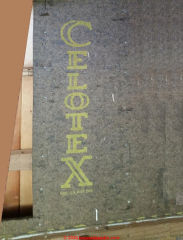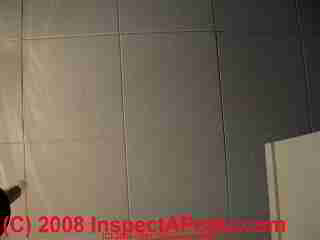 Catalog of Celotex® Insulating & Sheathing
Catalog of Celotex® Insulating & Sheathing
products that contain asbestos or that are asbestos-free
- POST a QUESTION or COMMENT about Celotex® Insulating & Sheathing.
Asbestos-containing products made by the Celotex corporation.
The following list names and comments on building products such as ceiling tiles and many other Celotex® brand building products & articles listed by some sources as believed to contain asbestos.
This article series assists building buyers, owners or inspectors who need to identify asbestos materials (or probable-asbestos) in buildings by simple visual inspection. We provide photographs and descriptive text of asbestos insulation and other asbestos-containing products to permit identification of definite, probable, or possible asbestos materials in buildings.
InspectAPedia tolerates no conflicts of interest. We have no relationship with advertisers, products, or services discussed at this website.
- Daniel Friedman, Publisher/Editor/Author - See WHO ARE WE?
Alphabetical list of Celotex™ insulating & other building products believed to contain or not contain asbestos
Photos above & below: excerpted from Celotex 1968 Products Reference Catalog include citation of asbestos cement ceiling panels including acoustical panels used in sound control. Catalog excerpts from 1968 Celotex Reference File on sale at eBay 2024/04/04.
[Click to enlarge any image]
- Celotex™ Acoustical Systems & Sound Control Systems - may contain asbestos per:
[1] Celotex 1973 Celotex Acoustical Systems catalog, January 1973
"Celotex-Houses from Sugar Cane: Mr. Bros Dahlberg and His Company," Fortune 19 (Feb. 1939): 80-84.
(Editor's note:Dahlberg headed Dahlberg sugar cane industries, beginning in Florida ca 1926. More detail is in
Dahlberg, Bros Gustave, "Raising Cane in Florida", in Sugar, Aeronautics Magazine, February 1930
1968 Celotex Product Reference File shown above and its identifying cover page just below - this catalog was observed for sale at eBay in 2024.
- Celotex™ Acoustical ceiling panels & Celotex ceiling tiles. Notes:
Asbestos fibers were used in some acoustic asbestos ceiling tiles, often amphibole asbestos such as amosite, crocidolite, anthrophylite, tremolite, and actinolite, with amosite among the most commonly-found.
Modern ceiling products do not contain asbestos.
See ASBESTOS CEILING TILE IDENTIFICATION . - Insulating panels.
See ASBESTOS INSULATION.
Photo: Celotex 12" x 12" ceiling tile installed late 1960's - early 1970's contributed by InspectApedia reader Bruce Pederson 2018-08-15.
- Celotex™ Brand ceiling tiles -
Suspended ceiling tiles of the 2'x2' or 2'x4' dimension, and manufactured by Armstrong, Celotex, Conwed, LoTone, and USG and made before the late 1970's are listed by several attorney-sponsored "mesothelioma websites" as often containing asbestos to add fire-resistance.Reader questions on Celotex ceiling tile asbestos:
Reader Question:
2018/08/15, Bruce Pederson said: Does Celotex style L-260 Matfair Stippled White Tile (12"x12") installed in the late '60's- early '70's contain asbestos? See box image above.
2017/12/12 [est] Saundra asked: We bought a house that was built in the 50's - it has what I THINK is a Celotex ceiling (or some copy of Celotex) - it's in horrible shape and needs to be taken down - what are your thoughts on it containing asbestos, considering the age? - SaundraReply: Apparently, yes.
Asbestos was used in some Celotex products and/or may appear in some Celotex products such as cellulose-based insulating board depending on when and where the product was manufactured.
On that basis, if the age of a Celotex™ ceiling is in that range it would be prudent to treat it as PACM.[9] Confirmation of asbestos content use & dates pending - Ed.]
Celotex was reorganized in 1997.
Celotex continues to operate in the U.K. selling polyisocyanurate insulating wallboard, not an asbestos product.
Question: do these Celotex 12x12-inch M250-1 Ceiling Tiles from 1982 contain asbestos?
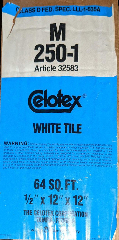 I found a box of Celotex M250 - 1 white tile 12x12 box also said article 32583 and the label had a date of 1/82. Are these safe? Could they contain asbestos? - Victor, 2020/04/21
I found a box of Celotex M250 - 1 white tile 12x12 box also said article 32583 and the label had a date of 1/82. Are these safe? Could they contain asbestos? - Victor, 2020/04/21
Photo: label on Victor's box of Celotex M250-1 white 12" x 12" x 1/2" ceiling tiles made in 1982. Note that nothing on the label itself mentions the use of asbestos
[Click to enlarge any image]
This Q&A were posted originallyat CELOTEX ASBESTOS PRODUCTS FAQs
Reply: probably not but ...
Thanks for the excellent photo and helpful question, Victor. Just above on this page
We provide an "Alphabetical list of Celotex™ insulating & other building products believed to contain or not-contain asbestos"There, even though we have not yet found an authoritative source, we state "Celotex™ Brand ceiling tiles - Suspended ceiling tiles of the 2'x2' or 2'x4' dimension, and manufactured by Armstrong, Celotex, Conwed, LoTone, and USG and made before the late 1970's are listed by several attorney-sponsored "mesothelioma websites" as often containing asbestos to add fire-resistance."
But what about Celotex fiberboard products, including ceiling tiles?
Regarding your 12x12-inch Celotex ceiling tiles (thanks for the excellent photo and helpful question)
I'm looking to see what else I can find about your Celotex M 250-1 white ceiling tiles and the asbestos question, but so far I've found that
"FS LLL-1–535 or Class E, ASTM C-208. " refers to a federal standard for fiberboard products. Also covered by ASTM C-208.
Fiberboard, in general, is a cellulose or "wood" based product. For example, as you'll see below, some Celotex fiberboard was made of cane waste (from sugar cane production).
Cellulose or wood is not an asbestos material.
Cellulose is plant-based fiber.
Asbestos is a mineral fiber. So if any fiberboard product such as a ceiling tile or wall sheathing contains asbestos it would have to be either1. asbestos added to improve fire resistance or to provide other desired properties
2. asbestos added by accident by cross-contamination if a fiberboard product was made at the same site where asbestos was being used, processed, or stored (we have reported on some cases of this)
Unfortunately, case 2 means that without knowing more, one cannot assert that an unfamiliar fiberboard product is absolutely without any possibility of containing any asbestos.
See SHEATHING, FIBERBOARD ASBESTOS CONTENT
50-mm-for more about that uncommon but possible case.
- Celotex™ Cane fiber products [Cane products were not an asbestos-containing product, though some may have been manufactured at facilities where asbestos was present - Ed.] Citation [2] at References or Citations
- Celotex sheathing [See Cemesto below]
- Celotex insulating lath (board) [this is probably a cellulose fiber insulating board; separately a gypsum based rock-lath was also produced]
- Celotex interior finish
- Celo-Siding [a cellulose fiber insulating board product]
- Details about cane board are
at CANEBOARD PANELS
Above: photo of Celotex cane-board insulating sheathing along with package labeling, provided by an InspectApedia.com reader . [Click to enlarge any image]
Below: Celotex Lay-In Fiberboard Ceiling Tiles date-stamped 3/82
Question: do these 1982 Celotex Ceiling Panels Contain Asbestos?
I just purchased a large volume of Celotex Fiberboard Lay-In Panels [photos above] from a private party that had posted on a Facebook page. The seller had told me that the material was in his basement and had been purchased but not installed by the previous owner.
It didn't even cross my mind that the material could contain asbestos until after it was delivered and my wife brought it up. I have included two photos of the label.
In the bottom right corner of one, I think there is a date listed as 3/82. My guess is that this is the date it was produced. This issue is causing me a great deal of anxiety as I may have done something stupid here. Any help you can offer would be so greatly appreciated. Thank you - anonymous by private email 2018/09/05 -
Reply:
Try to fight off the anxiety as that's more of a health risk than the hazard of possible-asbestos-containing ceiling panels still in boxes. Generally, "fiberboard" is a cellulose based product, not an asbestos one.
I suggest having a sample tested - cost about $40. - as that will tell us for sure if these panels, made rather close to when companies stopped using asbestos in such products - can be used or should be tossed out or returned to the vendor.
See ASBESTOS TESTING LAB LIST. Do let us know what you find as that will assist other readers.
On 2016-10-05 by jjhoggan120
Celotex ceiling tiles mayfair washable finish 260 class d-fed.spec.ss-a-118b, class 111-76 to 225 by astm e84 stamped 680813 12×12 typee-z. You think you could look it up some where. Does it have aspestas in it.
On 2016-10-04 by Randy Neibauer Celotex Now 107 Ceiling Tiles From 1999 Made In L'ance Michigan
I Have Some Celotex Now 107 Ceiling Tiles From 1999 Made In L'ance Michigan. Do They Contain Asbestos They Are Trim Edge 16 x 500m x 1500m Nominal... Label #: 000438... Thank You.
On 2016-03-02 by DAN
Does this product contain Asbestos... CELOTEX TEXTURE-TONE (R) SAFETONE(R) CELOTONE (R) LAY-IN PANELS MT 454 24"X 24" X 3/4 CLASS 25 FED SPEC, SS-S-118A
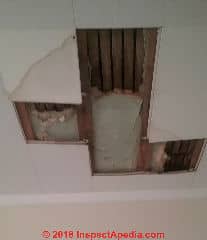 On 2018-12-09 by (mod) - Asbestos in Celotex Ceiling Tiles?
On 2018-12-09 by (mod) - Asbestos in Celotex Ceiling Tiles?
Shab
Please see CELOTEX CEILING TILES
It appears to me that your photo shows cellulose fiberboard panels over lath over which ceiling tiles were added still later.
On 2018-12-09 1 by Shah
We are tenants in a NYC house built approx.1927. We have had repeated leaks with collapsed ceiling and city violations were recently issued.
As a result of these violations, I see the name of the ceiling tiles are Celotex. Do these look like asbestos products?
- Celotex™ Celo-Rok Gypsum products - gypsum based sheathing boards used on walls & roofs both as finished surface products and as a base for plaster application. [some gypsum-based drywall as well as drywall compound may contain asbestos]:
Citation [2] at
References or Citations
- Celo-Rok anchor lath,
- Celo-Rock wallboards,
- Celo-Rok plasters
- See CELOTEX DRYWALL ASBESTOS
- Celotex™ Insulating building panels or "fiberboards - [Fiberboard is generally a wood-fiber product
See FIBERBOARD SHEATHING, Celotex Homasote & Other , but some products listed here include fiber-cement materials, probably due to confusion among attorneys who have erroneously lumped these materials together - Ed.]
Also see ASBESTOS INSULATION.- Celotex Cemesta products [2] - properly spelled Celotex Cemesto - see the Cemesto advertisement below. At least some Cemesto sheathing boards incorporated a layer of cement-asbestos board for both exterior and interior finish purposes. See the Cemesto advertisement and properties illustrated below.
- Thermo-board
- Carey Flex Board
- Carey Millboard
See ASBESTOS CEMENT MILLBOARD
also
see ASBESTOS CEMENT PRODUCTS
- Celotex Thermax Insulating board: some versions may have contained asbestos. See CELOTEX THERMAX ASBESTOS?
- Carey Asbestos Mine Celotex Products: Other Building insulation products including products directly associated with the Celotex-owned Carey Asbestos mine in Canada and containing asbestos include the following:
- Carey 7-M Asbestos Shorts
- Carey Block Insulation
- Carey Cemesto board [appears in some citations as"Carey Cenesto board"]
- Carey firefoil board & panels
- Careyflex board
- Careytemp masonry block insulation and blocks
- Carey Industrial A/C boards
- Carey Insulating Cement
- Carey Marine Panels
- Carey Stone corrugated sheets used for roofing & siding
- Carestone roofing & siding, Careystone wall sheathing & baffles
- Carey Thermalite
- CareyTemp insulating cement
- Carey MW-50 Insulating Cement
- Celobric insulating brick siding & Celobric "buff blend textured"
- Vitricel asbestos sheets
- More:
- Celotex care firefoil board and panels (contain asbestos)
- Carestone corrugated sheets (contain asbestos)
- Carstone roofing & siding (contain asbestos)
- Carestone sheathing & baffles (contain asbestos)
- Carey Cenesto board (contain asbestos) [Cemesto sic]
- Carey industrial A-C boards (contain asbestos)
- Carey marine panels (contain asbestos)
- Carey thermalite (contain asbestos)
- Careyflex board (contain asbestos)
- Carestone roofing & siding (contain asbestos)
- Building plumbing products
- Carey Pipe Covering & Careytemp pipe insulation
See CEMENT ASBESTOS PIPE MANUFACTURE
- Building roofing products
- Carey Fiberock Felt
- Careystone Corrugated Sheet
See CEMENT ASBESTOS SHEET PRODUCTS
- Building interior products
- Carey Asphalt Floor Tile
See ASBESTOS FLOOR TILES
- Carey Asphalt Floor Tile
What is Celotex Insulating Lumber? Did it contain asbestos?
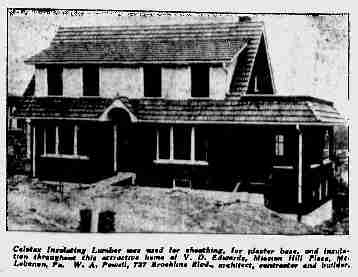 Reader question: I have a home built in 1940 that used a brown fiber board called "Celotex Insulating Lumber" looks like is was designed to be used as sheathing and lath.
Reader question: I have a home built in 1940 that used a brown fiber board called "Celotex Insulating Lumber" looks like is was designed to be used as sheathing and lath.
Made in either Chicago on Louisiana. Anyone familiar with this? Or know if it contained asbestos? - Dan Theisen 1/30/12
Reply:
Dan, Celotex, a Chicago company, has been a producer of a wide variety of insulating sheathing boards for a long time and the company continues to produce modern insulating board products as well.
Our illustration (left) shows Celotex insulating lumber on the exterior of a Lebanon PA home.
This insulating board is a wood-fiber product (actually made of bagasse fibers obtained from sugar cane, that is, cellulose) that we document in detail
at CELOTEX: IDENTIFY Celotex® Insulating Board and Fiberboard Products
And also
Asbestos was not among the product's ingredients.
Only if such products were produced at a manufacturing facility that also produced asbestos-containing products might there have been a risk of cross-contamination that could result in the detection of asbestos in the cellulose-based materials.
Asbestos in Celotex Gypsum Board (drywall) 4X8 panels?
This topic has moved to CELOTEX DRYWALL ASBESTOS where we illustrate Celotex gypsum board products, labels, and where we discuss possible asbestos content in Celotex brand gypsum board.
Also see see DRYWALL ASBESTOS CONTENT
Also see ASBESTOS TESTING LAB LIST if you need to demolish asbestos-suspect drywall or joint-compound or other asbestos-suspect materials.
Question: was asbestos used in Celotex Thermax foam core insulating board sheathing?
Jason Wojnowiak said:
I have a picture of some Celotex. IMG_5620.JPG
Would you know if this has asbestos?
Reply: some Celotex Thermax™ laminate insulating board products contained asbestos at least in patent disclosures
Jason,
Celotex Thermax™ was (and is currently as a Dow Thermax™ product) a foil-faced insulating board comprised chiefly of foam insulation, laminated with aluminum foil or possibly kraft paper.
Asbestos appeared in some, probably not all, foam insulating boards made up to the early to mid 1980's, particularly or more likely in fire-resistant products that incorporated a layer of asbestos paper.
Looking at photos you sent by email, I think your Thermax sheathing is a later polyisocyaurate foam insulating board reinforced with fiberglass and faced with aluminum foil, though of course an expert inspection of your material might find something different. Please see details about Celotex Thermax and its successor Dow insulating sheathing board, now found
at POLYISOCYANURATE FOAM BOARD
History of the Celotex Corporation: Background on Celotex & Asbestos
 Please see the new and more complete Celotex history information given
Please see the new and more complete Celotex history information given
Illustration: Shown here from a 1955 Sweets building product catalog, Celotex asphalt-based roofing and siding shingles might contain asbestos in the asphalt-impregnated felt backer.
While an expert lab test using polarized light microscopy may be needed to identify the specific type of asbestos fiber, or to identify the presence of asbestos in air or dust samples, many asbestos-containing building products not only are obvious and easy to recognize, but since there were not other look-alike products that were not asbestos, a visual identification of this material can be virtually a certainty in many cases.
See ASBESTOS FIREPROOFING SPRAY-On Coatings for photos of dangerous tremolite asbestos ceiling panels and photos of spray-on asbestos fireproofing coatings.
Also see CEILING FINISHES INTERIOR
and see ASBESTOS DUCTS, HVAC a field identification guide to visual detection of asbestos in and on heating and cooling system ducts and flue vents.
An example of an important Celotex product line that is not normally expected to contain asbestos is at
CELOTEX: IDENTIFY Celotex® Insulating Board and Fiberboard Products
and also at
CELOTEX STRONG-WALL FIBERBOARD SHEATHING
Also see
- CELOTEX STRUCTURAL INSULATION AND OTHER BUILDING PRODUCTS [PDF] (1954) from Sweets 1955 Construction Guide.
Here is similar, HIGH RESOLUTION [PDF] copy of the same document.
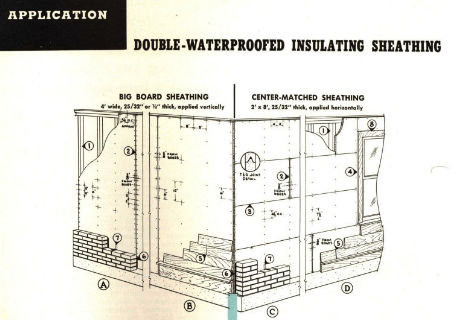 Celotex products described in this older document include
Celotex products described in this older document include
- Celotex Celo-Rok weatherproof (Core-Treated) sheathing
- Celotex Cemesto structural insulating panels - a laminate of cement-asbestos board over a cane fiber core - also see
CELOTEX CemestO BOARD HOMES - Celotex structural / insulating sheathing boards, asphalt coated and Ferox Process treated fibres resist termites & dry-rot
- Celotex sheathing backer board
- Celotex Celo-Rok anchor lath & Celotex insulating lath; also Celo-Rok plasters
- Celotex insulating interior finishes
- Celotex spun rock wool insulation products
- Celotex tile board & finish planks (pre-decorated finishes)
- Celotex Gypsum Sheathing Lath and plasters
- Celotex Gypsum Wallboard
- Celotex asphalt building products including asphalt roof shingles & siding panels simulating cedar, brushed cedar, brick, or stone. (Shadowlap, Deeptone, Celobric, and Lite-Line Celostone)
- Celotex Insulating sidings
- Celotex FlexCell expansion joint filler
References & Research on Asbestos in Celotex Products
- Bruce, Daniel C., "Composition of matter." U.S. Patent 1,804,245, issued May 5, 1931. The putty described by this invention was comprised of water, flour, borax and glycerine as well as a hydrocarbon such as gasoline or kerosene or benzene to form a preservative soap emulsion.
Abstract:
This invention relates to a composition of matter and it is an object of the invention to provide a composition of a soft putty consistency and which is particularly intended to be used as a filler in connection with the application of commercial wall board manufactured from fibres obtained from cane, asbestos, wood, flax, straw, or other absorbitant fibres such as, and including, the wall 1 board now used and manufactured and known as Celotex, Beaver board, Sheetrock, Best-wall, Masonite, Insolite, Gypsolite, Rockboard, Cornell, or Upson wall board, and other boards made from cane, asbestos, wood, flax, straw, or gypsum.
Another object of the invention is to provide a composition of this kind which is particularly intended for use in the filling of joints, covering nail heads and coating the surface of wall board, etc. An additional object of the invention is to provide a composition of this kind which is adapted to produce an invisible joint; to take the place of plaster, coating, or paint; and upon the omission of fibrous matter to produce a liquid composition for sizing walls before the application of paint or wall paper. ...
There is then added one pound of comminuted fibres taken from cane fibre or Celotex wall board fibres obtained from asbestos, wood, straw, or other absorbitant fibres. These fibres are thoroughly mixed with the admixture and kneaded until it forms a putty-like product.
In order to match the Celotex Wall board in color when cane fibres are used, suitable coloring matter soluble in water may be added to the first named admixture to obtain desired tints although ordinarily the composition when dry, owing to the action of the whiting or powdered chalk, causes the fibres to dry light in colorand thus prevent water stain[s]. - Celotex, "Cemesto, Five Tested Ways to Meet Today's Building Needs with Minimum Use of Critical Materials", The Celotex Corporation, Chicago, Architectural Record, October 1943 p. 16 [Advertisement] The ad describes several Celotex wallboard and sheathing products
- CELOTEX CemestO BOARD HOMES
- Eldredge, Merrill J. "Building construction." U.S. Patent 2,054,694, issued September 15, 1936.
Includes citation of use of asbestos in Celotex wallboard products:
Excerpt:
My invention consists of taking I-beams l, 2 and 3 and setting them spaced apart with panels A formed by securing sheets of insulation material 4 onto sheets of thin metal 5 and then securing the panels to the I-beams.
The insulation may be any of the type of insulation wall boards, such as might be made of fullers earth, or like material, or of a fibrous nature or with porous gypsum, or asbestos fiber and other compositions.
One type of these wall boards is sold on the market under the trade name of Celotex. - Hipchen, Donald E., Michael J. Skowronski, and Joseph R. Hagan. "Structural laminate and method for making same." U.S. Patent 4,118,533, issued October 3, 1978.
- Ohashi, Takashi, Toru Okuyama, Akira Suzuki, and Katsuhiko Arai. "Asbestos-metal surfaced urethane modified polyisocyanurate foam." U.S. Patent 4,292,361, issued September 29, 1981.
- Sandberg, Lynn, "Celotex in Upper Michigan", Forestry Division, The Michigan Tech Forester, Forestry Club, Michigan College of Mining and Technology, Houghton MI, Vol XII (1961) pp. 16-17. [No mention of asbestos in this article.]
- Tuscaloosa News, 14 June 1944, p. 7, classified ads, Excerpt: " For Sale - Make your own fan, limited lot ... Celotex celling tile board, Celotex insulation board, Celo-rock wall board for walls and celling, plaster, plaster lath. Kern-tone Miracle paint, ... All kinds of building materials. J. Oviatt Bowers Co., Phone 4456 14-3tp"
- Also see theReferences or Citations of this article for more citations
...
Reader Comments, Questions & Answers About The Article Above
Below you will find questions and answers previously posted on this page at its page bottom reader comment box.
Reader Q&A - also see RECOMMENDED ARTICLES & FAQs
Moderator reply: good news on Celotex ceiling tile test
That's good news, and thank you so much for the update - that information will be helpful to others.
Thank you for also providing a copy of the test report that would also be quite useful - of course we keep your personal information private.
A copy of the asbestos test report is on-file and an excerpt is given below [Ed.]
[Click to enlarge any image]
Mr. Close can be contacted by finding his state listing (Colorado or CO)
at ENVIRONMENTAL & MOLD TESTING SERVICES
Also see ASBESTOS TESTING LAB LIST
Reader follow-up: CeloTex 1/2" x 16" x 32" Ceiling Tile Board Asbestos Test Results: no asbestos
I emailed you a few weeks ago about some Celotex ceiling tiles I ended up having them lab tested and they were negative for asbestos. They appear to be a fiber board.
Doug Close from PhaseCon who did the report has been EXCEPTIONAL to work with. He also tested an old mobile home for me in order to destroy it, a process I had been dreading but Doug's expertise made it easier than I ever expected. If you have any resources for reputable consultants please add him. I cannot recommend him enough.
Email from our consultant is below:
No asbestos in that ceiling tile sample. I have attached the lab results here. I will send you a separate email with the invoice so that you can pay online with a credit card or simply mail a check to the address on the invoice. Thank you.
Doug Close
Phase Con Environmental Consultants, LLC
- Anonymous by private email 2022/03/18
On 2022-01-03 by Inspectapedia Com Moderator
@Anonymous,
Our intention and directing you to this page was to suggest that you read the information on Celotex that may contain asbestos.
But of course that does not assert that your specific ceiling tiles do contain asbestos.
Beyond reading the information above, the safe course is to treat the material as presumed to contain asbestos which means don't disturb it or make a dusty mess.
The ceiling tiles are not harmful if they're not being made into dust.
If you face an expensive demolition of the ceiling that can't be avoided then you either treated as presumed to contain asbestos or you test a sample.
If you decide to do that to let us know.
On 2022-01-02 by Anonymous - worried that our Celotex Tile Board ceiling contains asbestos
After reviewing the inspectapedia site I am concerned about the ceiling tiles that are throughout my home. The house is old (1903) and has undergone various stages of remodeling over the decades.
The ceiling in the livingroom and bedroom appear to be Celotex tiles of which I found a box in the basement. The box is in poor shape and the ceiling tiles in the basement are sagging and some are falling down.
Do you recognize the label I have forwarded to you? Do these appear to be the asbestos containing tiles?
I have also included a picture of them installed. Does this warrant further testing? Thank you so much for your time.
(Reposted by Moderator from a private email.)
Here's a second photo.
Here's the last photo showing the installed ceiling tiles.
On 2021-12-27 by Inspectapedia Com Moderator
@sherry harper,
Most likely any of the US brands.
Keep in mind that when you're talking about a seventy-year-old home it's very likely that the interior has been modified over its life.
Please see FIBERBOARD SHEATHING IDENTIFICATION https://inspectapedia.com/structure/Fiberboard-Sheathing-Identification-Key.php
On 2021-12-27 by sherry harper
what brand of fiberboard could be used for mobile home ceilings in the 50s in the united states? And if so, what is the list of the brands around that time period?
On 2021-03-14 by danjoefriedman (mod)
@Faith,
This is an asphalt-bound material coated with mineral granules; it's not friable; only if someone were chopping, sawing, grinding, making a dusty mess might there be a significant hazard.
You could side over the existing (probably two layers) material (presumably wood clapboards covered with asphalt shingle siding), appying housewrap and with or without using furring strips, new siding; The rub is that the windows and doors appear to recede into the building as the siding gets thicker and pokes out past those openings;
A common solution - more cost and work - is to build out window and door trim; that adds work but the total time and cost are probably less than removing the existing siding.
Continuing...
There were quite a few asphalt siding products similar in appearance to yours, and of a variety of colors.
Knowing the building's age, country, city of location would be helpful.
Those products may be thick asphalt-impregnated felt or may be asphalt impregnated felt bonded to fiberboard or hardboard.
The hazard of siding over is probably below the limits of detection; doing a dusty demolition could be more-serious, though if the material is removed intact, without grinding or sawing, dust should be minimal. It's not normally a friable substance.
On 2021-03-13 by Faith
@danjoefriedman,
Thanks for the quick reply, Dan! We will get a sample tested to find out. In searching online I have come across some people posting that they are trying to locate pieces for repairing homes, mostly of the brick-looking kind.
Is it really possible there is a market for this stuff? If it's safe to remove, we may need to do that if we want new siding.
There's already wood shingles below the asphalt siding and we've been told by some (not siding salesmen) that it's unwise to add a third layer of vinyl on top. Is there any other direction we might go with this?
On 2021-03-12 by danjoefriedman (mod)
@Faith,
There were a number of asphalt faced siding products that looked like the one in your photo.
Some of them are mounted on fiberboard for Masonite as a backer while others were thick asphalt impregnated paper-based material that was nailed directly to wood sheathing.
It would be common for asbestos to have been present in the asphalt impregnated paper backing of these materials.
If you were doing demolition project or sewing or grinding or chopping the material there would then be a potential hazard.
To know with absolute certainty you would of course need to have a sample tested for asbestos.
If you don't need to disturb the material, simply treat it as presumed to contain asbestos.
On 2021-03-12 by Faith
Hi, I'm really hoping somebody can help identify the asphalt siding on my house. It looks different than all the other examples I've found online. These are gray and each piece is 14 inches tall by 43 inches wide.
They lay flat against the house so there is no loose edge. except at the bottom of the wall. I'd really like to know what is in them before doing work on our house, including removing them or siding over them. Thanks!
On 2021-09-04 by inspectapedia.com.moderator (mod)
@thardu,
Yes and to you both I apologize if I am sometimes forced to be a bit mealy-mouthed weasel-worded.
Fact is, if it's wood, plant, bagasse cane fibre etc. as was used as the principal ingredient of these products, by definition it's not asbestos.
In the article I recommended we warn that while we've had trouble finding an authoritative source confirming specifics, there have been reports that SOME fiberboard that was made at facilities where asbestos was handled and asbestos-products were also being manufactured, there were instances of asbestos cross-contamination.
Often it makes the most sense to treat a material as PACM (Presumed Asbestos Containing Material) and to remove it with minimal dust and debris creation in any case, since demolition dust is likely to have other harmful stuff in it anyway, and because the cause of exhaustive testing may not be justified, especially for these questionable, low-probability cases.
When an asbestos test will make a significant difference in the cost of demolition, renovations, etc. does it make obvious sense to do the testing.
Else someone might be pouring out your money to reduce not your risk, but theirs.
On 2021-09-04 by thardu
@mike, well there you have the answer Mike. "The short answer is "no" for wood-based or plant-based products and "yes" for certain other (not plant-based) LDB or LDF products"..Like I said.. I just treated them as a "Yes".....
On 2021-09-04 by inspectapedia.com.moderator (mod)
@ thardu,
Please Take a look at
SHEATHING, FIBERBOARD ASBESTOS CONTENT inspectapedia.com/structure/Fiberboard-Sheathing-Asbestos.php
where that product is described and where we explain where the asbestos concern arose.
On 2021-09-04 by thardu
@Mike, I got lots of yes's and lots on no's .. So, simply to err on the side of caution. I treated them as if they contained asbestos and disposed of the same.
On 2021-09-04 by Mike
@thardu, did you ever get a response on your pic? I have the same fiberboard in my pole barn.
On 2020-08-10 by danjoefriedman (mod)
Thardu
See details at SHEATHING, FIBERBOARD ASBESTOS CONTENT https://inspectapedia.com/structure/Fiberboard-Sheathing-Asbestos.php
On 2020-08-02 by thardu
Can anyone shed some light as to the asbestos content of these 4' x 8' sheets. They are in my Father-in-laws garage and he just "passed" from mesothelioma. They are fairly
soft almost like a ceiling tile. Thanks in advance...
Question: Is there Asbestos in Celotex Fiberboard Sheathing?
Can anyone look at these pictures and tell if this Celotex on Exterior have Asbestos? In a home built in 1950s but has had several updates over the years most likely 1980s.
Thank u for info. - 2020/07/07
This Q&A were posted originally
at SHEATHING, FIBERBOARD ASBESTOS CONTENT
Moderator reply: probably not
Angelina
A short answer to your question: does my 1980s Celotex™ fiberboard insulating sheathing contain asbestos? is
Probably not.
Celotex™ Cane fiber products [Cane products were not an asbestos-containing product, though some may have been manufactured at facilities where asbestos was present - Ed.] Citation [2] - source: CELOTEX ASBESTOS PRODUCTS - above on this page.
Explanation:
Fiberboard, in general, is a cellulose or "wood" based product. For example, as you'll see below, some Celotex fiberboard was made of cane waste (from sugar cane production).
There was some question, not substantiated by any research I could find, that because some wood fiber board products may have been made at the same site where asbestos-containing materials had been used, that there may have been some cross contamination; that theory has not been supported. - source: SHEATHING, FIBERBOARD ASBESTOS CONTENT
In that article we address the question directly: Is there Asbestos Content in Insulating Board Products: Beaverboard, Celotex, Gold Bond, Homasote, Insulite, Nu_Wood?
Also take a look at
CELOTEX ASBESTOS PRODUCTS where we discuss the asbestos question in Celotex products.
There we note that
Asbestos is a mineral fiber. So if any Celotex or other brand of fiberboard product such as a ceiling tile or wall sheathing contains asbestos it would have to be either
1. asbestos added to improve fire resistance or to provide other desired properties
2. asbestos added by accident by cross-contamination if a fiberboard product was made at the same site where asbestos was being used, processed, or stored (we have reported on some cases of this)
Unfortunately, case 2 means that without knowing more, one cannot assert that an unfamiliar or "un-branded" fiberboard product is absolutely without any possibility of containing any asbestos unless you have a lab test for asbestos performed on a representative sample of the material.
On 2019-05-20 17 (mod) - edge tape identified gypsum board as Celotex Wallboard or "drywall" - dating from 1968 - may contain asbestos
Christy
The edge tape identifies your gypsum board as Celotex Wallboard or "drywall" - dating from 1968 it would be prudent to assume that the wallboard and its joint-compound-taped joints contain asbestos, and to avoid making a dusty mess.
Left undisturbed and in good condition there's not likely to be a detectable asbestos hazard from the walls or ceilings.
Yes drywall is heavy but may indeed have either been made in Tampa by Celotex or produced at a different plant by the same company using the same wallboard identification tape to mark the product's manufacturer's headquarters location.
Celotex had manufacturing locations - Stonebridge Park (1930s) in Suffolk and also Hadleigh and other locations in the U.K.
Celotex had manufacturing facilities in the U.S. at Tampa, Florida, and at more locations given
at CELOTEX ASBESTOS PRODUCTS and
also in more detail at CELOTEX HISTORY & PRODUCTS
live links are given at MORE READING
On 2019-05-20 Christy
My house was built in 1968. Does the Dryboard have asbestos? It says wallboard Tampa Florida and our house is in Idaho. Seems a long way to have been shipped.
IMAGE LOST by older version of Clark Van Oyen’s useful Comments code - now fixed. Please re-post the image if you can. Sorry. Mod.
...
Continue reading at DO THESE CEILING TILES CONTAIN ASBESTOS? or select a topic from the closely-related articles below, or see the complete ARTICLE INDEX.
Or see CELOTEX ASBESTOS PRODUCTS FAQs - Q&A posted originally at this page
Or see these
Recommended Articles
- ASBESTOS-SUSPECT CEILING COVEROVER
- ASBESTOS-FREE CEILING TILES
- ASBESTOS TESTING LAB LIST f certified asbestos testing labs
- CEILING TILE MATERIALS
- CELOTEX ASBESTOS PRODUCTS
- CELOTEX CemestO BOARD HOMES
- CELOTEX DRYWALL ASBESTOS
- CELOTEX HISTORY & PRODUCTS
- CELOTEX: IDENTIFY Celotex® Insulating Board and Fiberboard Products
- FIBER CEMENT SIDING - home
- FIBERBOARD SHEATHING IDENTIFICATION
- POLYISOCYANURATE FOAM BOARD - more about Celotex and Dow insulating sheathing
Suggested citation for this web page
CELOTEX ASBESTOS PRODUCTS at InspectApedia.com - online encyclopedia of building & environmental inspection, testing, diagnosis, repair, & problem prevention advice.
Or see this
INDEX to RELATED ARTICLES: ARTICLE INDEX to ASBESTOS HAZARDS
Or use the SEARCH BOX found below to Ask a Question or Search InspectApedia
Ask a Question or Search InspectApedia
Try the search box just below, or if you prefer, post a question or comment in the Comments box below and we will respond promptly.
Search the InspectApedia website
Note: appearance of your Comment below may be delayed: if your comment contains an image, photograph, web link, or text that looks to the software as if it might be a web link, your posting will appear after it has been approved by a moderator. Apologies for the delay.
Only one image can be added per comment but you can post as many comments, and therefore images, as you like.
You will not receive a notification when a response to your question has been posted.
Please bookmark this page to make it easy for you to check back for our response.
IF above you see "Comment Form is loading comments..." then COMMENT BOX - countable.ca / bawkbox.com IS NOT WORKING.
In any case you are welcome to send an email directly to us at InspectApedia.com at editor@inspectApedia.com
We'll reply to you directly. Please help us help you by noting, in your email, the URL of the InspectApedia page where you wanted to comment.
Citations & References
In addition to any citations in the article above, a full list is available on request.
- 3/07: thanks to Gary Randolph, Ounce of Prevention Home Inspection, LLC Buffalo, NY, for attentive reading and editing suggestions. Mr. Randolph can be reached in Buffalo, NY, at (716) 636-3865 or email: gary@ouncehome.com
- [1] Celotex 1973 Celotex Acoustical Systems catalog, January 1973
- [2] Celotex Home Building Materials, 1947 catalog, lists: Cane fiber products: Celotex sheathing, Celotex insulating lath (board), Celotex interior finish, Celo-Siding, Celo-Rok Gypsum products [may contain asbestos]: Celo-Rok anchor lath, Celo-Rock wallboards, Celo-Rok plasters, and Other Products: Celotex rock wool, Celotex roofing, Celotex hard boards, Celotex Cemesta, Celotex Corporation, Chicago IL
- [3] Celotex Insulating Cane Board, product catalog
- [4] Celotex Building Insulating Materials, 1948 Catalog, listing: Cemesto insulation, Cemesto roof decks, Cemesto exterior wall coverings, Cemesto interior wall coverings [we believe the Cemesto lines refer to cement-asbestos products - ed. ]
- [5] Celotex Sound Conditioning, 1948 Catalog, including perforated asbestos board sheets
- Celotex ceiling products division was purchased by Ceiling Products & Gypsum Wallboard (BPB) of the U.K. beginning in 1999
- Celotex roofing products division was purchased by Certainteed Corporation (Valley Forge PA) beginning in 1999
- [7] "Board of Education for the School District of the City of Detroit v. Celotex, et al., Circuit Court of Wayne County, Michigan, No. 84-429634-ND"
- [11] Celotex [UK] History, Celotex Insulation Specialists, web search 6/30/12, original source: http://www.celotex.co.uk/celotex-history [Copy on file as Celotex_History_UK.pdf ]
- [13] Brian Greer, "History of Tin Ceilings", Brian Greer's Tin Ceilings, web search 6/30/12, original source: http://www.tinceiling.com/company/historytin.php
- [14] Armstrong Corporation, "Corporate History: a Historical Summary", web search 6/30/12, original source: https://www.armstrongflooring.com/corporate/corporate-history.html
- [15] "Ceilings Pressed in Time", Old House Journal, web search 6/30/12, original source: http://www.oldhousejournal.com/ceillings_pressed_in_time/magazine/1070
- [16] Steven Mlynarek, Morton Corn, Charles Blake, "Asbestos Exposure of Building Maintenance Personnel", Regulatory Toxicology and Pharmacology, 23, 213–224 (1996) ARTICLE NO. 0045, http://library.certh.gr/libfiles/PDF/GEN-PAPYR-4810-ASBESTOS-by-MLYNAREK
-in-RTAP-VOL-23-ISS-3-PP-213-224-Y-1996.pdf - [17] National Institute of Occupational Safety and Health (NIOSH) (1989). In NIOSH Manual of Analytical Methods (P. M. Eller, Ed.), Method 7400. NIOSH, Washington, DC.
- [18] U.S. Environmental Protection Agency (USEPA—Green Book) (1990). In Managing Asbestos in Place: A Building Owners Guide to Operations and Maintenance Programs for Asbestos-Containing
- [19] U.S. Department of Labor, Occupational Safety and Health Administration (USDOL) (1994). In Occupational Exposure to Asbestos: Final Rule, FR Vol. 59, No. 153:40964–41162. Materials, Report 2OT-2003. USEPA, Washington, DC.
- [20] U.S. Department of Labor, Occupational Safety and Health Administration
(USDOL) (1986). In Occupational Exposure to Asbestos: Tremolite, Anthophyllite, and Actinolite: Final Rule, FR Vol. 51, No. 119:22631–22644. - [21] U.S. Environmental Protection Agency (USEPA) (1990). In Environmental Asbestos Assessment Manual, Superfund Method for the Determination of Asbestos in Ambient Air, Part 2, Technical Background Document, Report EPA/540/2-90/005 b. USEPA, Washington, DC
- [22] Ceiling - Frequently Asked Questions, Armstrong Corporation, web search 6/30/12, original source: https://www.armstrongflooring.com/resclgam/na/ceilings/en/us/article17697.html
- [23] BPB America Inc., 5301 West Cypress St., Suite 300, Tampa, FL 33607, Tel: 866-427-2872 E-mail: crc@bpb-na.com Web: www.bpb-na.com. Acoustic ceiling tile & accessories.
- [24] Affa Tile Company No. 1116/8, Poonamalee High Road, Opposite Hotel Shan Royal, Koyambedu Chennai, Tamil Nadu - 600 107, India, E-Mail: affatiles@gmail.com website: http://www.affatiles.com Tel:044-24757498, 044 - 24757497
- [25] Made-in-China.com, online sevice to connect buyers with product suppliers in China, web search 6/30/12
- [26] "Directive 2003/18/EC of the European Parliament and of the Council of 27 March 2003 amending Council Directive 83/477/EEC on the protection of workers from the risks related to exposure to asbestos at work". Publications Office of the European Union. 27 March 2003 Web search 6/30/12, original source: http://eur-lex.europa.eu/LexUriServ/LexUriServ.do?uri=CELEX:32003L0018:EN:NOT,
- [27] H. M. Murray, testimony before the Departmental Committee on Compensation for Industrial Diseases "Minutes of Evidence, Appendices and Index", 1907. p. 127
- [28] D. Auribault, "Note sur l'Hygiène et la Sécurité des Ouvriers dans les Filatures et Tissages d'Amianté (On hygiene and security of the workers in the spinning and weaving of asbestos)" in Le Bulletin de l'Inspection du Travail, 1906, pp 120–132.
- [29] Wikipedia entry on Asbestos and various citations from that article, web search 6/30/12, original source: en.wikipedia.org "Asbestos"
- Asbestos Identification and Testing References
- Asbestos Identification, Walter C.McCrone, McCrone Research Institute, Chicago, IL.1987 ISBN 0-904962-11-3. Dr. McCrone literally "wrote the book" on asbestos identification procedures which formed the basis for current work by asbestos identification laboratories.
- Stanton, .F., et al., National Bureau of Standards Special Publication 506: 143-151
- Pott, F., Staub-Reinhalf Luft 38, 486-490 (1978) cited by McCrone
- Asbestos products and their history and use in various building materials such as asphalt and vinyl flooring includes discussion which draws on ASBESTOS, ITS INDUSTRIAL APPLICATIONS, ROSATO 1959, D.V. Rosato, engineering consultant, Newton, MA, Reinhold Publishing, 1959 Library of Congress Catalog Card No.: 59-12535 (out of print, text and images available at InspectAPedia.com).
- "Handling Asbestos-Containing roofing material - an update", Carl Good, NRCA Associate Executive Director, Professional Roofing, February 1992, p. 38-43
- EPA Guidance for Controlling Asbestos-Containing Materials in buildings, NIAST, National Institute on Abatement Sciences & Technology, [republishing EPA public documents] 1985 ed., Exposure Evaluation Division, Office of Toxic Substances, Office of Pesticides and Toxic Substances, U.S. Environmental Protection Agency, Washington,D.C. 20460
- In addition to citations & references found in this article, see the research citations given at the end of the related articles found at our suggested
CONTINUE READING or RECOMMENDED ARTICLES.
- Carson, Dunlop & Associates Ltd., 120 Carlton Street Suite 407, Toronto ON M5A 4K2. Tel: (416) 964-9415 1-800-268-7070 Email: info@carsondunlop.com. Alan Carson is a past president of ASHI, the American Society of Home Inspectors.
Thanks to Alan Carson and Bob Dunlop, for permission for InspectAPedia to use text excerpts from The HOME REFERENCE BOOK - the Encyclopedia of Homes and to use illustrations from The ILLUSTRATED HOME .
Carson Dunlop Associates provides extensive home inspection education and report writing material. In gratitude we provide links to tsome Carson Dunlop Associates products and services.


